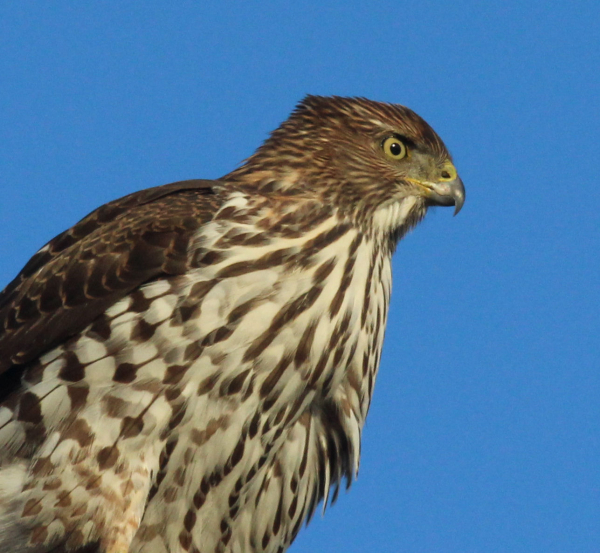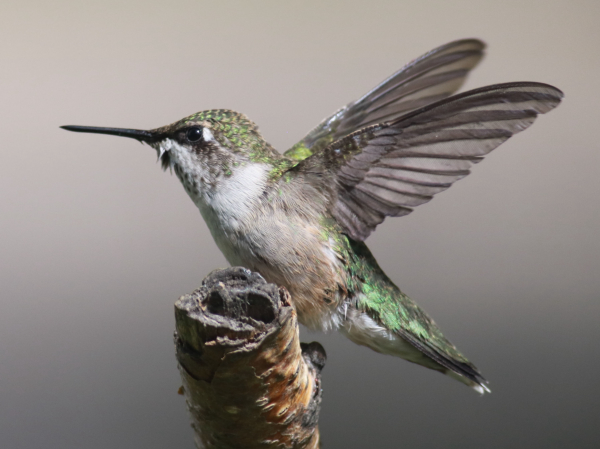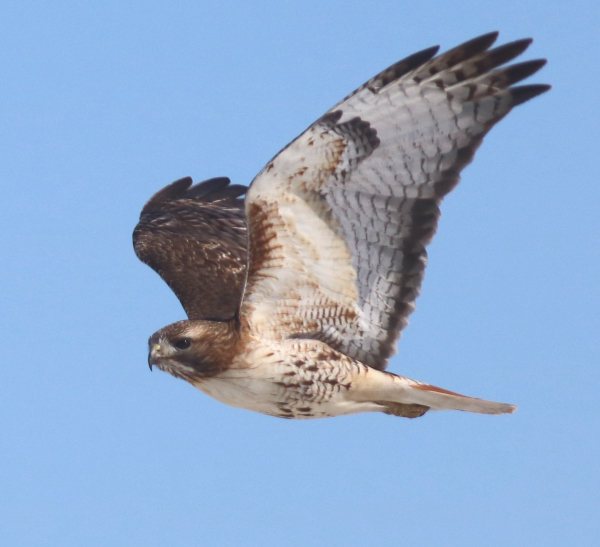
A young female Cooper’s Hawk was one of four Coops observed moving through the area last week.

A favorite Ruby-throated Hummingbird photo taken last Tuesday as it perched two feet to the side of a nectar feeder.

Relatively abundant now across the open plains during early migration, a Red-tailed Hawk is always exciting to see in flight at close quarters.
|
I was tipped off to an adult Cooper’s Hawk by a hummingbird that flushed while I was photographing it at my nectar feeder. When the hummer startled, I looked up to see the Coop flying low overhead, possibly checking out the action around my feeding station. It came from my backyard, where I heard a robin give an alarm call a few moments earlier. Later Thursday, as I was returning home from a short drive, I spied 2 young Cooper’s Hawks, a male and a female, that flew into a little grove of trees about 2 miles south of my feeding station. To keep with the theme, on Saturday I saw another immature Cooper’s Hawk about 7 miles south.
Red-tailed Hawks were scattered across the region throughout the week as they move through the area in a generally southern pattern. With each Red-tail sighting, I checked in vain for some of the rarer Red-tail morphs, including the very light-colored Krider’s and dark morph Harlan’s, but each hawk is interesting on an individual level, and I appreciate seeing each one.
The week also yielded some new migrating songbirds, including a female Yellow Warbler and the first Tennessee Warbler Thursday. Early Friday a young Yellow Warbler was foraging near my feeders, and during separate visits, an adult male American Goldfinch and a Brown Thrasher perched at my feeding station; both checked it out, but moved on without so much as a drink of fresh water.
Friday’s Birding Drive
My Friday evening drive to the Bald Eagle nest provided some nice views of an active fledgling Red-headed Woodpecker there, but no adults were evident. I was surprised to see a big female Great Horned Owl fly from a tree near the eagle nest that landed on a pole near me, but no eagles were obvious in the area. Two miles northwest of the eagle nest I observed 2 more Red-headed Woodpeckers – a fledgling and an adult – and observed the adult catch a big bug and feed it to the fledgling. I found these woodpeckers 2 weeks ago, but haven’t reported them in this weekly description before.
Along the way, there were many passage Red-tailed Hawks, a scattering of 3 kestrels, plus a couple late season Swainson’s pairs still on territory. On my way back to the office, I swung by the lake with the late duck broods that I found last week, and accounted for all of them – the Redheads, Mallards, and Gadwalls, all a week to 10 days old now. There were also many loafing Blue-winged Teal, a few Northern Shovelers, a Great Egret, many American Coots, a few Pied-billed Grebes, and 20 White-faced Ibis – all in an area of shallow water that recently flooded a new arm of the lake.
A Week of Subtractions
The birds at my feeding station experienced a notable week of subtraction, with the young Baltimore Oriole leaving first, last Tuesday night perhaps. By Thursday the Blue Jays were obviously absent too. The Ruby-throated Hummingbirds peaked at 9+ Tuesday evening, and Wednesday through Friday there were at least 4 hummers around, and by Saturday 3 was probably the maximum. Throughout the week I certainly enjoyed photographing hummingbirds at and near my feeders, which I describe in this issue of The Birding Wire in the Bird Photography article near the bottom of the issue.
Monday, I was pleasantly surprised to see a new addition to my feeding station, a Gray Catbird that fed repeatedly at my grape jelly feeder. While I had lots of catbird action earlier in the summer, I haven’t seen a catbird for more than a month. It’s also the only Gray Catbird I’ve seen here in September – hope it sticks around, and is joined by other migrating birds. Keep alert for birds in your yard and during birding outings as different birds will probably appear weekly, and enjoy the process.
Article and photos by Paul Konrad
Share your bird sightings and photos at editorstbw2@gmail.com